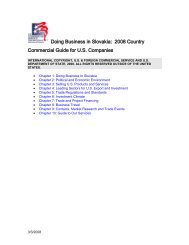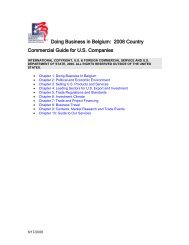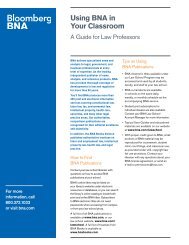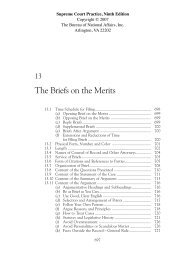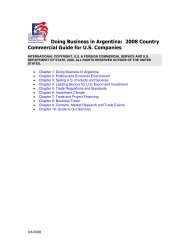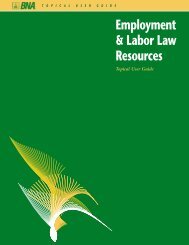Doing Business In (Insert Country Name Here) - BNA
Doing Business In (Insert Country Name Here) - BNA
Doing Business In (Insert Country Name Here) - BNA
Create successful ePaper yourself
Turn your PDF publications into a flip-book with our unique Google optimized e-Paper software.
percentage of sugar, milk fat, milk protein and starch in the product. These additional<br />
import charges may make certain imported processed products non-competitive in the<br />
European market, vis-à-vis similar products produced in the EU. <strong>In</strong>terested U.S.<br />
exporters should contact the Office of Agricultural Affairs for up-to-date information on<br />
this issue.<br />
The EU tariff schedule is based on the Customs Cooperation Council Nomenclature<br />
(CCCN), which is also referred to as the Harmonized System. This system was<br />
introduced to provide a standard tariff classification regime for all products imported and<br />
exported throughout the world. Agriculture has high import tariffs in order to maintain a<br />
strict regime of what type of produce and meat are accepted into the EU. Hormonetreated<br />
beef continues to be banned by the EU despite WTO rulings that the ban violates<br />
international trade agreements. The decreasing average for industrial manufacturing<br />
goods is expected to be around 3 per cent over the next few years.<br />
Trade Barriers Return to top<br />
For information on existing trade barriers, please see the National Trade Estimate<br />
Report on Foreign Trade Barriers, published by USTR and available through the<br />
following website:<br />
[http://www.ustr.gov/Document_Library/Reports_Publications/2007/2007_NTE_Report/S<br />
ection_<strong>In</strong>dex.html?ht=]<br />
<strong>In</strong>formation on agricultural trade barriers can be found at the following website:<br />
[http://www.useu.usmission.gov/agri/usda.html]<br />
To report existing or new trade barriers and get assistance in removing them, contact<br />
either the Trade Compliance Center at [http://www.trade.gov/tcc] or the U.S. Mission to<br />
the European Union at [http://www.buyusa.gov/europeanunion]<br />
The following concerns trade barriers specific to France.<br />
Enforcement of complex technical standards and lengthy testing procedures sometimes<br />
appears to exceed reasonable requirement levels needed to assure proper performance<br />
and safety, for example in the areas of electronics, telecommunications equipment, and<br />
agriculture phytosanitary standards. There has been progress towards removal of nontariff<br />
barriers in trade with France and other EU countries under WTO agreements and in<br />
the context of the transatlantic dialogue, and toward harmonization of standards through<br />
mutual recognition agreements (MRAs).<br />
The 1989 EU Broadcast Directive requiring a "majority proportion" of television<br />
programming to be of European origin was incorporated into French legislation on<br />
January 21, 1992. France specifies a percentage of European programming (60<br />
percent) and French programming (40 percent). These broadcast quotas were<br />
approved by the EU Commission and became effective on July 1, 1992. They are less<br />
stringent than France's previous quota provisions, which required that 60 percent of all<br />
broadcasts be of EU origin, and that 50 percent be originally produced in French. The<br />
60 percent European/40 percent French quotas are applicable throughout the day, as<br />
well as during prime time slots. The prime time rules go beyond the requirements of the<br />
2/15/2008 <strong>Country</strong> Commercial Guide for France 72<br />
INTERNATIONAL COPYRIGHT, U.S. & FOREIGN COMMERCIAL SERVICE AND U.S. DEPARTMENT OF STATE,<br />
© 2007. ALL RIGHTS RESERVED OUTSIDE OF THE UNITED STATES.



